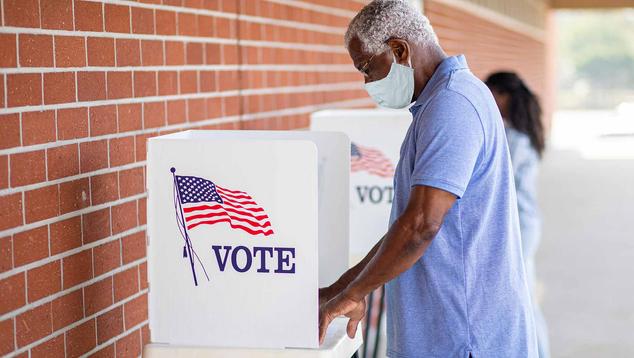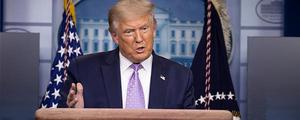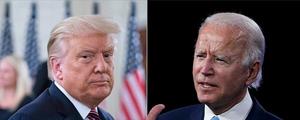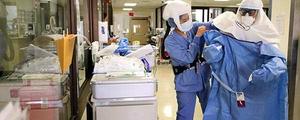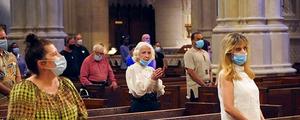Story Highlights
- Seven in 10 giving a lot of thought to the election, the most this cycle
- Republicans and Democrats paying equivalent levels of attention
- Republicans still more enthusiastic than Democrats about voting
WASHINGTON, D.C. -- With the presidential election campaign intensifying and the pandemic heading into its sixth month, more Americans are thinking about the election than did so in April. A higher percentage now than at the start of the pandemic also feel enthusiastic about voting.
At the same time, the political contours of Americans' connection to the campaign haven't changed. Today, as from January through April, Republicans and Democrats are paying comparable attention, while Republicans hold the edge on enthusiasm about voting.
Highest Percentage Thus Far Giving a Lot of Thought to 2020 Election
Seven in 10 Americans report giving a lot of thought to the election in Gallup's latest poll, conducted July 30-Aug. 12. This is the highest rate of public attention recorded thus far in the 2020 election cycle, starting from last fall.
Public attention to the election had waned in late April -- falling to 59%, from 67% in February -- as surging cases of COVID-19 dominated the news and disrupted Americans' lives.

Line graph. Trend from 2019 to August 2020 in Americans' self-reported amount of thought given to the 2020 election. The percentage giving quite a lot of thought is now 71%, up from 59% in April and from between 59% and 67% earlier in the cycle.
The 71% paying a lot of attention today is on par with the levels seen in August or September of the last four presidential election years, including 2004, 2008, 2012 and 2016. Attention was considerably lower in 2000.
Republicans and Democrats Equally Attentive to the Campaign
Attention to the presidential election is up 13 percentage points in the latest poll among both party groups, which include independents who lean toward each party. Seventy-two percent of Republicans and 76% of Democrats are now giving "quite a lot of thought" to the election.
| Republicans/Leaners | Democrats/Leaners | ||||||||||||||||||||||||||||||||||||||||||||||||||||||||||||||||||||||||||||||||||||||||||||||||||
|---|---|---|---|---|---|---|---|---|---|---|---|---|---|---|---|---|---|---|---|---|---|---|---|---|---|---|---|---|---|---|---|---|---|---|---|---|---|---|---|---|---|---|---|---|---|---|---|---|---|---|---|---|---|---|---|---|---|---|---|---|---|---|---|---|---|---|---|---|---|---|---|---|---|---|---|---|---|---|---|---|---|---|---|---|---|---|---|---|---|---|---|---|---|---|---|---|---|---|---|
| % | % | ||||||||||||||||||||||||||||||||||||||||||||||||||||||||||||||||||||||||||||||||||||||||||||||||||
| 2020 Jul 30-Aug 12 | 72 | 76 | |||||||||||||||||||||||||||||||||||||||||||||||||||||||||||||||||||||||||||||||||||||||||||||||||
| 2020 Apr 14-28 | 59 | 63 | |||||||||||||||||||||||||||||||||||||||||||||||||||||||||||||||||||||||||||||||||||||||||||||||||
| 2020 Feb 17-28 | 66 | 72 | |||||||||||||||||||||||||||||||||||||||||||||||||||||||||||||||||||||||||||||||||||||||||||||||||
| 2020 Jan 16-29 | 65 | 61 | |||||||||||||||||||||||||||||||||||||||||||||||||||||||||||||||||||||||||||||||||||||||||||||||||
| Gallup | |||||||||||||||||||||||||||||||||||||||||||||||||||||||||||||||||||||||||||||||||||||||||||||||||||
Party comparability on election thought is not unprecedented but is also not the norm. Typically, more Republicans than Democrats indicate they are paying attention to presidential elections. The exceptions to the historical pattern occurred during most of the 2008 election cycle and for brief periods of the 2000 and 2004 cycles. However, Republicans have had an advantage on this measure in the final preelection survey in each election year since 1992 (the years in which Gallup can analyze data by party identification), including 2008.
Enthusiasm About Voting Also Ticks Up
The percentage of Americans describing themselves as "more enthusiastic" about voting this year than in previous elections is back above 60% after dipping below that level in February and April.
At the same time, the percentage of Americans feeling "less enthusiastic" about voting is also up slightly, with the current 31% the highest recorded in this election cycle. Fewer Americans now volunteer that their enthusiasm is "the same."

Line graph. Trend from October 2019 to August 2020 in Americans enthusiasm about voting this year compared with usually. After dipping to 56% in April, the percentage feeling more enthusiastic is back to 63%, where it was in January.
Today's level of enthusiasm is relatively high for August of an election year, matched only by 2004, when 67% said they felt more enthusiastic than usual about voting. However, the trends show that enthusiasm typically increases to the low to mid-60s by Election Day. The one exception is 2016, when relatively few adults felt more enthusiastic about voting in both May (46%) and November (47%), perhaps because of the historical unpopularity of the two major-party candidates.
Both party groups feel more enthusiastic about the election today than they did in April -- Democrats up 10 points to 64% and Republicans up eight points to 70%.

Line graph. Trend from October 2019 to August 2020 in the percentage of Republicans and Democrats feeling more enthusiastic about voting this year than usual. Republicans maintain an edge on this measure -- six percentage points, 70% to 64% -- similar to the pattern since January. Last October, the two were roughly tied.
Although Republicans have maintained an edge over Democrats in enthusiasm thus far in 2020, Gallup trends suggest this is not a reliable indicator of success in November.
-
Republicans also reported more enthusiasm than Democrats about voting in 2016 and 2012, but the GOP candidate prevailed in only one of these -- Donald Trump in 2016 -- and that was while losing the popular vote.
-
Republican George W. Bush also won in 2004, but that was with neither party holding a clear advantage on enthusiasm in November. For most of the year, Republicans and Democrats traded the lead on enthusiasm, with some of the jockeying reflecting the impact of the party conventions.
-
Democrats maintained an extraordinarily large advantage on enthusiasm in 2008, first as they waged a hotly contested campaign for the nomination, with the historic implication of choosing either the first woman or first Black American to be a major-party standard-bearer. Democrats' enthusiasm advantage continued after Barack Obama became the nominee and ultimately won the election.
Implications
About halfway through an unusual election year in which the main news story has not been the presidential race but the worst pandemic in a century as well as recent attention to racial justice, Americans are showing renewed interest in the election after somewhat diverting their attention in the spring.
Gallup's "thought given to the election" question has historically been a valuable tool in predicting turnout levels, based on the final preelection reading. The high levels of attention both parties are giving would normally point to a high-turnout election, with neither party poised to benefit from the other party's voters staying home. How this plays out in 2020 with increased reliance on mail voting is unclear.
While less reliable for indicating which party is headed for victory, the enthusiasm measure may be useful when one party has an extreme advantage, such as in 2008. Right now, the Republicans' advantage is modest. Where this stands in the fall, after both parties have held their nominating conventions, will provide insight into how well this year's abridged conventions rallied their respective bases and set the candidates up for success in November.
View complete question responses and trends (PDF download).
Learn more about how the Gallup Poll Social Series works.
